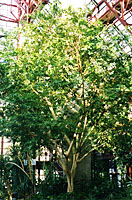Terry L. Ettinger Horticulture Consulting Services
Meeting The Needs Of Today With A Vision For The Future
Question of the Week
Low Light and Winter Leaf Drop
 Q. We bought a beautiful weeping fig tree that had three trunks braided together at a local home improvement
center about a month ago. Within the past two weeks a lot of the leaves have started turning yellow and dropping off.
I water the plant every two or three days, but the problem seems to be getting worse! Whatís wrong with our plant?
Q. We bought a beautiful weeping fig tree that had three trunks braided together at a local home improvement
center about a month ago. Within the past two weeks a lot of the leaves have started turning yellow and dropping off.
I water the plant every two or three days, but the problem seems to be getting worse! Whatís wrong with our plant?
A. Weeping fig trees, (Ficus benjamina) are native to equatorial regions of Malaysia and India where the daylength varies less than an hour throughout the year and sunlight is quite intense. And those offered for sale at garden centers, home improvement centers and even grocery stores across Central New York are grown in large outdoor nurseries in Florida, Texas, California, etc., where conditions are relatively similar to those found throughout their native range.
Unfortunately, conditions inside most Central New York homes arenít even remotely similar to those found near the equator - especially during late autumn, winter and early spring!
Instead of a relatively constant 12 hours of daylight near the equator, there's just under nine hours between sunrise and sunset on December 21st. And, instead of a bright sun shining through a clear blue sky, we rarely get bright sunshine thanks to all the clouds that form over Lake Erie and Ontario!
So, what your fig tree is telling you that it wants to go home!
The thick leaves dropping from your tree were adapted to the high light intensities of a southern nursery. Providing that you don't kill your tree with too much water, these leaves will eventually be replaced by new, thinner leaves that are better adapted to low light levels inside your home.
While this ďchanging of the leavesĒ is taking place, let the potting soil become slightly dry to the touch between waterings. Donít fertilize your plant until late March or early April. And, keep it in as sunny of a spot inside your home as possible yet, at the same time, a location where night temperatures will drop to the low to mid-50ís.
As the days become longer and brighter next spring, begin watering the plant a little more frequently to keep the soil just slightly moist and apply a water-soluble houseplant fertilizer (10-10-10, 20-20-20, etc.) once a month between April and August according to label directions. And, after the chance of frost has passed in mid- to late May, you may even want to set it outside for the summer in a spot where it will receive direct morning sun and dappled afternoon shade!
Once weeping fig trees have adapted to their new homes, they can survive - and thrive - for many years!